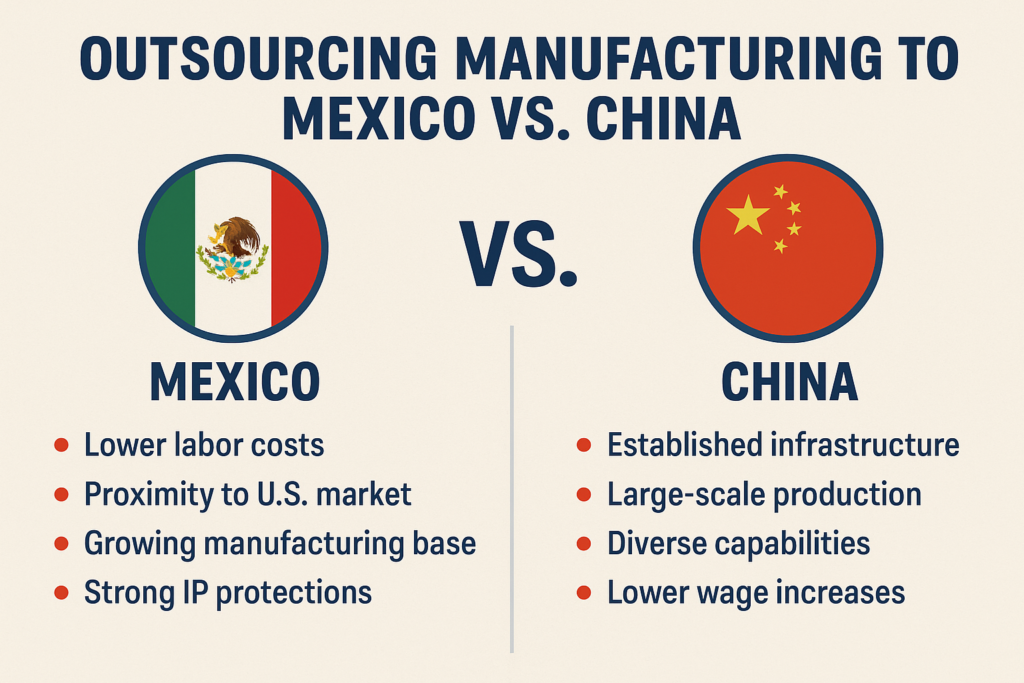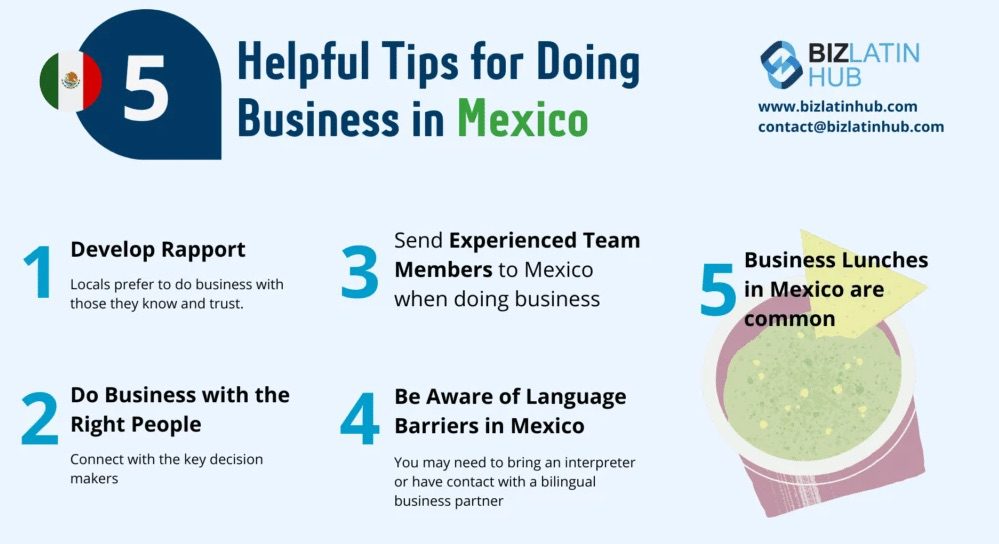Last Updated on June 3, 2025

If you’re looking at outsourcing manufacturing, odds are you’ve already bumped into the usual suspects: Mexico and China. They’re the heavyweights in this conversation. But here’s the thing—what worked a decade ago may not make sense today. The rules have changed. Costs, speed, politics, risk—it’s all shifting under our feet. So let’s break it down. This post is your side-by-side guide to outsourcing manufacturing to Mexico vs. China. And trust me, there’s more than just labor rates to consider.
Cost Isn’t Everything… But It Still Matters
Both Mexico and China offer unique advantages in terms of cost. As a result of its low labor costs, China has long been an attractive option for businesses with a low budget. The labor costs in China have increased steadily, resulting in a narrowing of the cost gap between the two countries.
Mexico, on the other hand? Wages are still highly competitive, especially when you factor in logistics savings. You don’t need to wait weeks for a boat across the Pacific. You can truck your product from Matamoros to Dallas in less than 24 hours. That speed saves money—on storage, on customs, and on your customer’s patience.
So if you’re just chasing the cheapest option? Be careful. China might look cheaper at first—but Mexico often wins on total landed cost.
According to Trading Economics, citing the country's Ministry of Human Resources and Social Security, China's minimum monthly wage stood at 960 yuan renminbi in 2009, equating to roughly $131 that year. Over the next 12 years, this rose nearly 170 percent to 2,590 yuan in 2024, or around $353, where it remains unchanged today.
Newsweek
Quality & Capabilities: Can Mexico Keep Up?
Manufacturing outsourcing requires the assurance of product quality. Although China has an established manufacturing infrastructure and extensive experience, quality control can sometimes be a challenge. Depending on the language barrier, cultural differences, and geographical distance, there may be a communication gap and potential quality issues.
In contrast, Mexico's proximity to the United States makes collaboration and communication easier, reducing quality control complications.
Furthermore, Mexico has made significant improvements in quality standards and prioritizes meeting customer needs.
Logistical Advantages
Because of Mexico's geographic proximity to the United States, it offers logistical advantages that cannot be ignored. Due to shorter shipping distances and reduced transit times, Mexican manufacturers can respond quickly to market demands, resulting in faster deliveries and lower inventory costs.
Speed to Market: It’s Not Just About Production Time
Let’s be honest: consumers don’t wait anymore. Supply chain delays aren’t just frustrating—they’re a liability. And when your factory is across the globe, every hiccup becomes a full-blown headache.
China’s got robust infrastructure, no doubt. But it’s far. Congestion in ports, container shortages, and customs delays pile up.
Due to a surge in bookings from China to the United States, key ports in China (Shenzhen) and the United States (Los Angeles, New York) are experiencing significant congestion in May 2025. The surge is related to a pause in tariffs, when the US lowered its tariffs on China from 145% to 30%.
Mexico offers a serious edge here. Proximity isn’t just convenient—it’s strategic. Trucks can roll over the border with less red tape (especially under the USMCA). That means faster delivery, easier site visits, and fewer translation nightmares.

IP Protection: Trust is Hard to Ship Overseas
This one’s tricky. China has made progress in intellectual property laws, but enforcement remains… inconsistent. If you’re worried about copycats or losing control over proprietary tech, China can feel like a gamble.
Mexico, meanwhile, benefits from trade agreements like the USMCA, which strengthen IP protections and legal recourse. And because you're operating closer to home, it's a lot easier to monitor what's going on.
If your product includes sensitive tech or you’re entering a crowded market, Mexico may be the safer bet.
Geopolitical Risk: Reading the Room
Politics can change the game overnight. Trade tensions, sanctions, pandemics—they all shake supply chains. Just ask anyone who’s had to rework shipping routes mid-COVID or been blindsided by a sudden U.S.-China tariff spike.
Mexico’s political and trade relationship with the U.S. is more stable. Sure, there are policy shifts now and then, but Mexico isn’t under the same microscope. And being part of USMCA? That’s a strategic cushion many businesses are leaning on.
Hidden Bonus: Cultural Compatibility
Let’s not underestimate how much smoother things can be when teams work in sync. Mexico shares not just a border with the U.S., but time zones, work culture, and business values. That means fewer late-night calls and more real-time problem-solving.
You’ll probably find it easier to collaborate with Mexican teams. Bilingual managers, shared holidays, similar customer expectations—it all helps.

Okay, So Who Wins?
It depends. If you need deep technical capacity at massive scale and you’re willing to navigate distance and complexity, China still makes sense. But if you’re looking for speed, cost-efficiency, stability, and transparency—Mexico is becoming the obvious choice.
Outsourcing manufacturing to Mexico vs. China isn’t just a cost comparison anymore. It’s a strategic decision tied to risk, time, control, and where you see your business going.
And honestly? For many U.S. companies, the smart money is heading south.
FAQs on the Pros and Cons of Outsourcing Manufacturing to Mexico vs. China
Q1: Which country offers lower labor costs, Mexico or China?
A1: Historically, China has been associated with lower labor costs, but Mexico offers competitive labor rates while providing proximity to the US market.
Q2: Are quality control issues more common when outsourcing to China or Mexico?
A2: Quality control issues can arise in both countries, but the proximity of Mexico to the US allows for easier collaboration, potentially reducing quality control complications.
Q3: Which country has better intellectual property protection, China or Mexico? A3: Mexico has made significant progress in intellectual property protection, while China still faces challenges in this area.
Q4: Can manufacturers in Mexico respond quickly to market demands?
A4: Yes, Mexico's geographical proximity to the US enables manufacturers to be more responsive to market demands, thanks to shorter shipping distances and reduced transit times.
Q5: Which country is more suitable for accessing the US market, Mexico or China?
A5: Mexico's proximity to the US makes it a favorable choice for accessing the US market, offering reduced shipping costs and shorter lead times.
Q6: How do tariffs affect the choice between Mexico and China?
A6: U.S. tariffs on Chinese goods can significantly raise costs, whereas Mexico benefits from tariff-free access under the USMCA agreement.
Explore More: Discover Related Blog Posts
Expand your knowledge and delve deeper into manufacturing in Mexico vs. China with our curated collection of related blog posts.
- The Workforce in Mexico vs. China: Which is More Skilled and Cost-effective?
- Environmental Sustainability: Why Manufacturing in Mexico is More Responsible Than in China [2024]
- The Importance of Intellectual Property Protection in Mexico versus China [2024]
- The Pros and Cons of Outsourcing Manufacturing to Mexico vs. China [2025]
- Mexico’s Proximity Gives It the Edge Over China
- 5 Reasons Why Mexico is a Better Choice for Manufacturing Than China
- Benefits of Manufacturing in Mexico vs. China: Which Country Offers More Value for Your Business?
- The Impact of Trade Agreements on Manufacturing in Mexico and China
- Closeness Counts: Why Sourcing For Manufacturing in Mexico Trumps China for Business Success [2024]